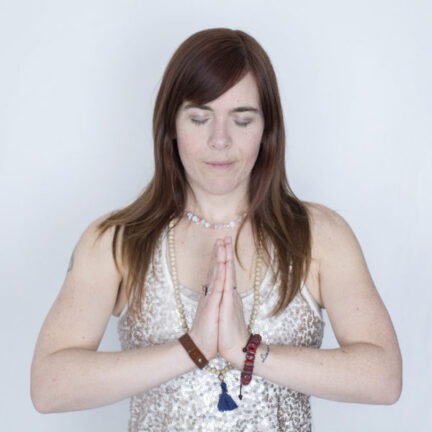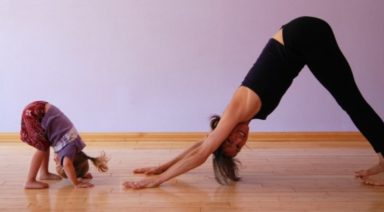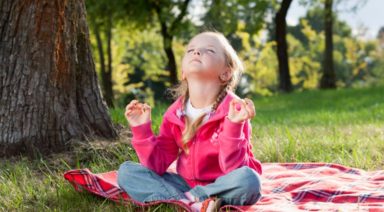5 Ways Yoga Can Help Postpartum Depression and Anxiety

There is nothing worse than going from the feelings of pure joy and complete satisfaction to fear and frustration—sometimes in a single day. Many women get postpartum depression or anxiety after their babies are born, and many women do not. Sometimes these feelings do not even set in until well into the first year of a baby’s life. It is more common than you think for a new mom to feel intense anxiety, fear, frustration or sadness.
The best we can do to prepare for any big change in our lives is to perform the practices of yoga, because our minds and our hearts will know what to do when the challenges begin to arise. These practices are intended to be sprinkled throughout the busy day of a mom. Taking between one and five minutes several times a day to center in can be a powerful practice, and should not be underestimated. Do what you can to take care of yourself on a daily basis, and just consider it part of your regular routine – along with changing diapers, preparing food and playing with your kids!
1. Breathe. Performing any type of breathwork can be extremely valuable to have in your toolbox when things start to get overwhelming. It is important to understand that you do not need to have tons of time on your hands in order to practice breathwork. You can breathe with intent for ten seconds and it could help change your perspective. Try this: Close your eyes. Focus on drawing the breath into the belly, expanding the belly as much as you can. On the exhale, release any held tension in the shoulders, eyes, jaw and forehead. Take 5 – 10 breaths.
2. Focus. Here I use the word focus, because it is much less intimidating than the word meditation. But really, I am asking you to do a few minutes of meditation. Try this: Close your eyes, and draw your attention to your third eye (the space between the eyebrows). Begin to pour your awareness into that space, perhaps visualizing an orb of white light resting there. Breathe consciously into this orb, perhaps expanding it. Take 5 – 10 breaths.
3. Love. Love is everywhere. You do not have to see it all of the time, but just know that it is there. Take the time to seek out love – in your child’s face, in the sounds of nature, in the changing colours of the sky. Seek out love, and enjoy the sensations of it. Use the memories of love to bring you into that vibration when you begin to feel anxious, sad or lonely. Try this: Draw a heart in red crayon and write down the things you love inside. Tack it up somewhere so you can see it often.
4. Acceptance and Letting Go. This is a good practice to use when practicing asana. Some incredible poses for acceptance and letting go are: Pigeon, Fish and Forward Bends. Try this: Get into one of the above-mentioned poses, and work your way to the edge of comfort and discomfort. The idea is to go towards any feelings of tension, tightness or emotion. Breathe into that space, and perhaps even say in your mind, “I see you, and I accept you”. By acknowledging the feeling, it will naturally soften, making way for more space and freedom in your body and mind.
5. Present Moment Awareness. It is important to remember that while many people will tell you that the baby and toddler years go by very quickly, it can sometimes feel like each day repeats itself and drags on. That is because you are forced to live in the moment, not as a chosen meditative practice or a soothing yoga class, but as your life. Try this: Greet each moment consciously and say in your mind what is happening, “I am walking into baby’s room, I am saying hello to baby, I am picking baby up with love. I am sitting on the floor with baby, all she sees is me. I am loving my baby, I am loving my child.” And once baby gifts you with a quiet moment to reflect on your day, relish it, forget the laundry and the dishes. And accept the gift of the present moment.
There is no way that I could go into detail here about the many challenges of motherhood, and the ways that I personally got through those intense first years. And there is no perfect way to cope with the ups and downs of becoming a mother. The most important thing to remember with the transition of motherhood is that you cannot get around it – you simply must go directly through it. Expand on these ideas in your own way, and be sure that once you have landed on the other side of the transition, that you pass on your knowledge and hard-earned wisdom to someone else.
How to Teach Kids Yoga

Children are overwhelmed. More than ever in my 15 years as an educator I observe our children being affected by anxiety, depression, and a host of other issues that impact learning and the ability to develop skills such as self-regulation. Yoga is an evidence-based tool to provide children with the skills to self-regulate. I see it working everyday in a variety of settings. In teaching kids yoga, I have found there are 3 vital elements needed to teach yoga to kids: a teaching philosophy, my own yoga practice, and the understanding of child development.
Genshai: Help Kids See Their Greatness
In Aspire by Kevin Hall, I fell in love with the word Genshai. It’s an ancient Hindi word meaning “never to treat others, or yourself, in a way to make them feel small.” It’s more than that, though, it’s helping people see their greatness. How does this philosophy apply to leading children’s yoga?
Amy Defillipi, a psychotherapist and yoga teacher, suggests that five positive impacts have the same affect as one negative experience on the brain. So let’s imagine a child’s day. He rides the school bus with a friend. He does well on a spelling test. He plays at recess with others. He gets called on to share in circle time. All of these events can be easily forgotten if on the bus home, no one wants to sit with him. How can we prepare the child to savor the positive experiences and allow them to sink in? How can we aim to develop children’s positive self-talk? To help the children recognize their greatness, we need to see good in ourselves.
Mind Your Self-Talk
I believe it’s a teacher’s responsibility to be kind to him/herself when working with children. Below the age of seven, children mimic what we say and do. That being the case, a teacher’s behaviors ought to be model behavior. We all make mistakes, and we all struggle. But with increased negative thoughts and words come increased instances of depression and anxiety. Is it possible for us to become so mindful of our self-talk that it would be consistent with seeing our greatness?
Challenge: Practice Genshai Toward Yourself
- Practice saying, “I love you just as you are,” as you look yourself in the mirror every day
- When something unexpected happens, pause to notice the quality of your thoughts and words. What are your thoughts and words? Once you take a deep breath or two, invite yourself to try again. Kindly respond to yourself the way you would to your childhood self. What changes?
- Write down of all the accomplishments you manage throughout the day such as exercising, making it to work, and being kind. Then when something unexpected happens, you can more easily see the big picture of all that you accomplish. Phew! Tailspin averted
- Compliment yourself for your accomplishments. If you start to talk down about yourself, stop! Refer back to number 2
It’s important to see all people as whole beings right now. Seeing children as flawed does not honor their greatness. Children should feel safe to make mistakes and exhibit a wide range of behaviors in your presence without our judgment or belittlement. In a kids yoga setting, participation will look different for all children. Be prepared to welcome a range of participation and behavior. Here are a few tips that I offer in my teacher training.
Challenge: Practice Genshai With Children
Create Clear Behavior Expectations
Small children need to know how you want them to behave. Knowing allows them to feel confident and increases the likelihood of participation. To set expectations; try simply repeating the same statements as you start class each time. If you make a practice of reminding kids that, “In yoga, we sit criss-cross apple sauce on our yoga mats”, and during class a child gets off his or her mat, you can simply ask, “where do our bodies belong during yoga class?” Question asking jogs the memory and helps bring the child back with kind inquiry. He or she will think, “Oh yea, we sit on our yoga mats,” and not, “I am bad because I left my mat.” The latter of the two thoughts can be the unintended result of a teacher getting mad when children make normal mistakes. Remember that children are dealing with constant distractors such as bodily sensations, sounds from inside or outside the classroom, seeing toys, etcetera, and therefore distraction is to be expected. Children should not be reprimanded for their mind (or body) wandering, but kindly redirected to the proper behaviors that have been clearly set. The goal of yoga and mindfulness after all, isn’t to never become distracted; it’s to return from distraction to attention with kind curiosity.
Accept Different Forms of Participation
Some children observe and listen rather than “do” yoga, especially toddlers. Some children won’t be confident or comfortable enough to practice yoga in front of other people. Forcing participation is damaging to children. Instead, verbally accept other forms of participation. For example, “some of our friends are working hard watching and listening while others are trying out the poses. Thanks for participating in your own way.” It can be tempting to emphasize ‘good yoga poses.’ Try to refrain from focusing on the physical form, but the energy and effort involved.
If a Child is Not Participating Physically, Check-In
You may hear, “Yoga is weird.” Or “Yoga is just for girls.” Acknowledge that child’s trepidations. “I thought yoga seemed weird a first, too. Now I find breathing and yoga poses calming and empowering. Do you ever want to feel more powerful?” I have seen relating to kids on this level help them relax more into learning.
Develop and Maintain Your Practice
I recommend that teachers have a regular yoga practice so they are comfortable doing yoga. You will be a better teacher if you have your own experience and know how practices feel for you and how they shift your energy. For example, you may not know that forward folds are calming until you try them and your experience may differ. Create a regular home practice, which can be as simple as adding one pose or sequence and a breath to your morning routine. I challenge you to begin a regular yoga practice. Consider sun salutations before work, or belly breathing to calm down on the commute.
Differentiate Your Practice
I have seen many skilled yogis and yoga teachers flounder in a kids yoga setting. That’s because kids yoga is different than adult yoga. That is why it’s important to study with a kids yoga expert so you learn to sequence engaging age-appropriate classes. In my Flow and Grow Kids Yoga teacher training, we encourage graduates to shadow other teachers and co-teach when they are starting out. When preparing to teach, select a few activities and rehearse them to ensure you use simple and clear language. Rehearse a few activities per week and you will have built up a repertoire of curriculum.
Understand Early Childhood development
(Infancy to Seven) According to Flower Yoga founder Tara Rachel Jones, author of It’s Time for Yoga, in early childhood, children experience the world as a one big sense organ. That means their entire body receives input from the world around them like a porous sponge. Finger-play is a tool for toddlers and preschoolers to experience a mind-body connection. The use of the fingers, toes, and skin is important because they contain neural-receptors. Tara Rachel contends, “A Finger-play is a gateway for the developing child that interconnects Head, Heart and Hands. Head: through rhythmic and imaginative language; Heart and Hands: it creates a 3 dimensional gesture that guides the articulation of the hand as a gentle helper of the heart. Furthermore, from a yogic perspective, Finger-plays are wonderful and age-appropriate precursor to a future Mudra practice (meditative hand postures that relate to positive thinking).”
Teaching Considerations
Speak slowly. Class should be 15-45 minutes. Create a familiar ritual such as ringing a chime. Include breathing activities. Be sure to ask the kids what they know about yoga and let them know what it means to you. Include a finger-play to start an imaginative journey that also includes rhythm, repetition, animals, nature, transportation, and emotions. End the yoga exploration by gradually slowing down. Ease each child into relaxation for one to three minutes. When wrapping up, ask what they enjoyed. Thank them for participating.
Yoga for Kids: Fun Finger Practice
A fun yoga practice for the kiddos to help stimulate learning. Practice this anywhere!
The Shy Turtle
Yoga Practice for Kids by Lara Hochieser
Do this finger-play several times slowly. It can be done facing one child, in a circle with a group, or with partners in a group. And remember to thank your partner or group when done!
- Say: “When turtle is feeling shy”
- Do: Hold the right fist at chest height with the turtlehead (thumb) pointing toward your center, slowly wiggling your thumb
- Say: “she/he hides in his/her shell”
- Do: Slowly open the fist one finger at a time, tuck the thumb in and close the fist the same way you opened it. Then put your hand in your lap
- Repeat the finger-play with your left hand and say “When I am feeling shy I hide in my shell”
- Say: “Come out turtle”
- Do: Bring the right fist back out with the turtle’s head out
- Repeat for the left hand
- Option to Connect deeper: Replace “turtle” with the children’s name, giving each person a turn
- Add turtle pose asana: After repeating the finger-play several times, consider adding turtle asana. Explain “Put your feet together. Wiggle your heart forward and put your head down.” While they do this, repeat, “When turtle’s feeling shy she hides in her shell.” “Come out turtle,” and sit up tall again
- Add breathing: While the children are “in their shells” ask them to take 3 slow deep breaths in and out the nose. You can count aloud for them or alternatively breathe audibly
- Memory: Ask the child what to say to help turtle come out of her shell
- Move: Turtle “walk” by scooting on the bum. Move forward and back doing turtle pose
- Imagine: Ask kids questions. At this age there is no understanding of rhetorical questions. So when you ask a question, they will shout out their answers!
- Optional questions: What color is the inside of turtle’s shell? How does turtle get to school in the morning?
- Create empathy: Ask questions to stimulate emotional literacy. Ask only one or two questions, as more can be overwhelming. “What are times it feels good to be in your shell? How do you know when to come out? Ask turtle to be your friend. What would you say?
Keep studying
My greatest sources of inspiration are the children and my teachers. The best teachers remain students. To learn kids yoga, will you sit in the seat of student?





































